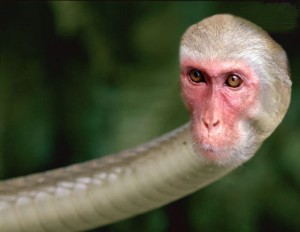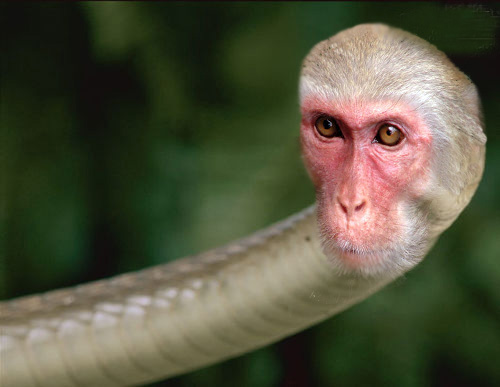The Word of the Week comes from the Grass-Mud Horse Lexicon, a glossary of terms created by Chinese netizens or encountered in online political discussions. These are the words of China’s online “resistance discourse,” used to mock and subvert the official language around censorship and political correctness.
hóu shé 猴蛇

Monkey-snake. (Source: Baidu Tieba)
Creature of Chinese Internet mythology representing state media and propaganda; homophone of “mouthpiece” (hóushé 喉舌).
The role of the media, according the Chinese Communist Party, is to serve as the Party’s mouthpiece. China Media Project traces the origin of this duty to the founding of the CCP itself. A test for journalists to obtain press cards, released in 2013, explains, “Unlike Western countries, the most important function of news media in our country is to be the ears, eyes, throat and tongue for the party and the people.” The Mandarin word “mouthpiece” breaks down to the characters hóu喉 (throat) and shé 舌 (tongue).
Netizens evoke the “monkey-snake” to satirize state media and the propaganda apparatus. A description of the monkey-snake has circulated on websites on both sides of the Great Firewall, such as Baidu Tieba, Baike.com, and Twitter:
Monkey-snake, primate of the simianus serpentii family. It has a developed brain, a humanoid face, the head of a monkey, and the body of a snake. A face also appears on its buttocks. Adept at mimicking human speech, but mostly utters lies. Appearing in Russia approximately 100 years ago, the monkey-snake was once wide-ranging in Eastern Europe, Northeast Asia, and Africa. Today, it lives in Northeast Asia and Latin America. Variation presents in the species, but those seen in mainland China and the Korean Peninsula are considered purebred. On April 1, 2009, Chinese scholar Ling Cangzhou proposed that April 1 be marked as “Chinese Monkey-Snake Day,” in order to raise awareness of this endangered species.
猴蛇,属哺乳纲灵长目猴蛇科。大脑发达,颜面似人,猴首蛇身,臀部亦呈脸状。善模仿人语,但多说假话。约一百年前出现在俄罗斯,一度广泛分布于东 欧、东北亚、非洲等地,现存于东北亚及中南美洲等地。该物种形态各异,但以分布在中国大陆及朝鲜半岛北部之品种较为纯正。因种群稀少,中国民间学者凌沧洲 2009年4月1日提议将每年的4月1日定为“中国猴蛇节”,以加强对该物种的重视及保护。[Chinese]
The monkey-snake appeared in Weibo gripes about the 2016 CCTV Lunar New Year gala, which many netizens panned for being overly political:
Yilianwusuowei (@一脸无所谓): I think the monkey-snakes are clearly more sycophantic than under the late emperor. (February 8, 2016)
感觉这几年猴蛇明显比先皇时更谄媚了。[Chinese]
Piaoliangdedamao (@漂亮的大猫): Of course the media approves of it. They’re all monkey-snakes controlled by your Party. If they don’t applaud, it’s off with their heads. (February 8, 2016)
媒体点赞我相信,都是被你党控制的猴蛇,不喊好要被杀头的。我就好奇这个“网民齐”是谁?[Chinese]
@150BPM: I give China’s monkey-snakes 100 points. (February 10, 2016)
我给中国的猴蛇打100分 [Chinese]
Can’t get enough of subversive Chinese netspeak? Check out “Decoding the Chinese Internet: A Glossary of Political Slang,” an ebook with dozens of new terms and classic catchphrases, presented in a new, image-rich format. Available for pay-what-you-want (including nothing). All proceeds support CDT.








